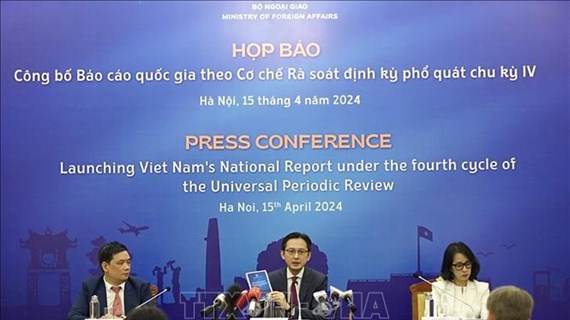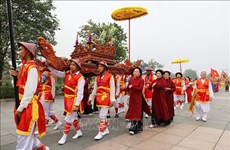Theatre compiles anthology
The Royal Hue Traditional Arts Theatre has completed an anthology of
traditional arts, including nha nhac (court music), tuong (classical
theatre) and royal dances, plus a profile of artists.
The Royal Hue Traditional Arts Theatre has completed an anthology of
traditional arts, including nha nhac (court music), tuong (classical
theatre) and royal dances, plus a profile of artists.
Theatre director Truong Tuan Hai said 20 practitioners of the traditional arts lived in Hue or its surrounds.
The anthology had been compiled from staff research and field trips to meet artists who performed for members of the Nguyen dynasty, he said.
The research took more than a year and the invaluable material collected was compiled into a 250-page profile of the artists and a glossary of the works they perform.
It includes 22 90-minute tapes and 45 20-minute DVDs of their performances.
The artists surveyed include Tran Kich, who served the court in the early 20th century, and helped record 30 pieces of royal music.
Although its roots can be traced to the Ho dynasty (1400-07), court music reached its zenith at Hue's royal court during the Nguyen dynasty from 1802 to 1945.
Various international organisations have supported the city in preserving royal music. The Republic of Korea recently helped remake bronze bells and stone instruments, crafts that are still popular today.
The set of bronze bells and stone instruments will be finished by the end of this year and will be used in the Xa Tac worshipping ceremony dedicating gods of land and agriculture at the beginning of next year and at the Nam Giao worshipping ceremony dedicating heaven during the Hue Festival next year.
Between 2005-08, the Japan Trust Fund, through UNESCO, gave 154,900 USD for a project to study, collect, store and restore the court music.
This has helped the younger generation gain access to court music and introduce it to other regions and countries.
Court music was originally found in the courts of royalty and reserved for annual ceremonies and special events such as coronations, funerals and official receptions./.
Theatre director Truong Tuan Hai said 20 practitioners of the traditional arts lived in Hue or its surrounds.
The anthology had been compiled from staff research and field trips to meet artists who performed for members of the Nguyen dynasty, he said.
The research took more than a year and the invaluable material collected was compiled into a 250-page profile of the artists and a glossary of the works they perform.
It includes 22 90-minute tapes and 45 20-minute DVDs of their performances.
The artists surveyed include Tran Kich, who served the court in the early 20th century, and helped record 30 pieces of royal music.
Although its roots can be traced to the Ho dynasty (1400-07), court music reached its zenith at Hue's royal court during the Nguyen dynasty from 1802 to 1945.
Various international organisations have supported the city in preserving royal music. The Republic of Korea recently helped remake bronze bells and stone instruments, crafts that are still popular today.
The set of bronze bells and stone instruments will be finished by the end of this year and will be used in the Xa Tac worshipping ceremony dedicating gods of land and agriculture at the beginning of next year and at the Nam Giao worshipping ceremony dedicating heaven during the Hue Festival next year.
Between 2005-08, the Japan Trust Fund, through UNESCO, gave 154,900 USD for a project to study, collect, store and restore the court music.
This has helped the younger generation gain access to court music and introduce it to other regions and countries.
Court music was originally found in the courts of royalty and reserved for annual ceremonies and special events such as coronations, funerals and official receptions./.













